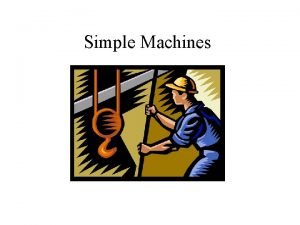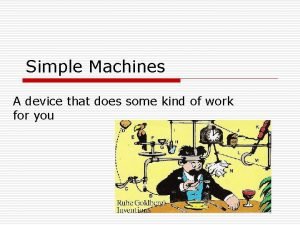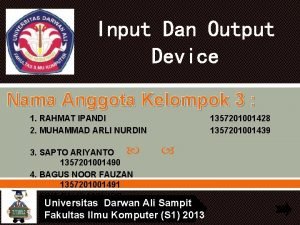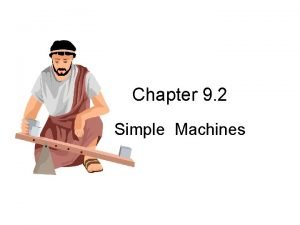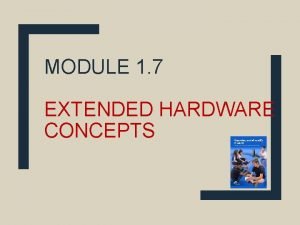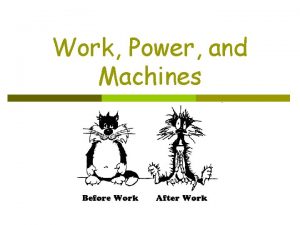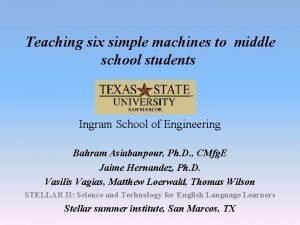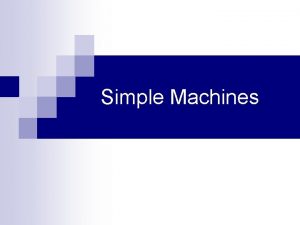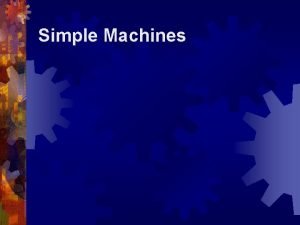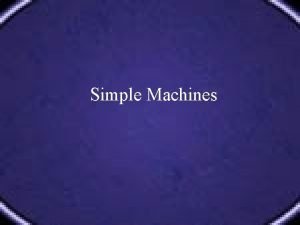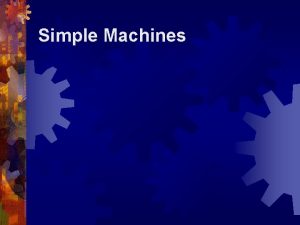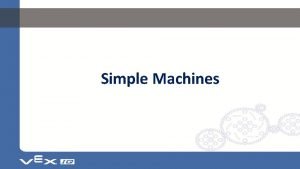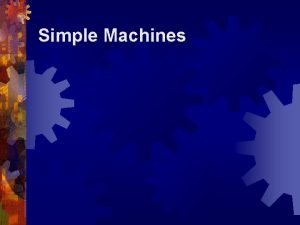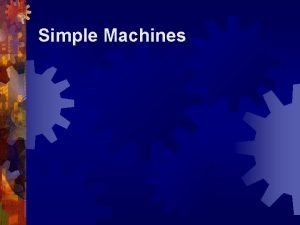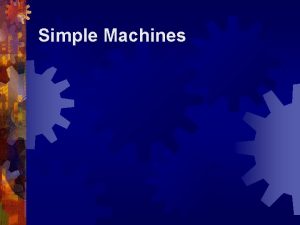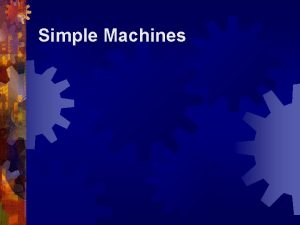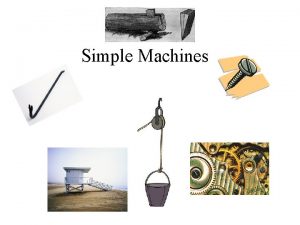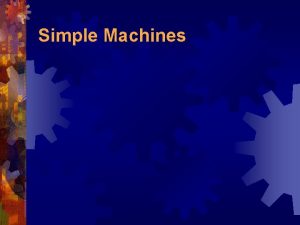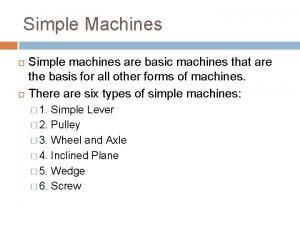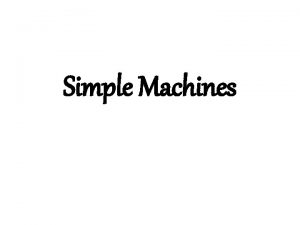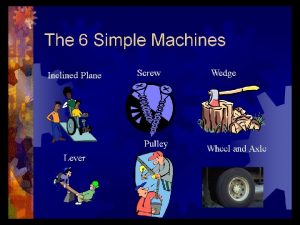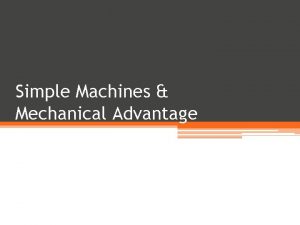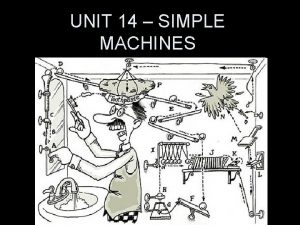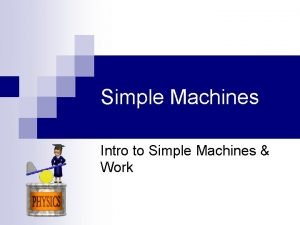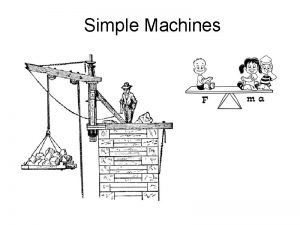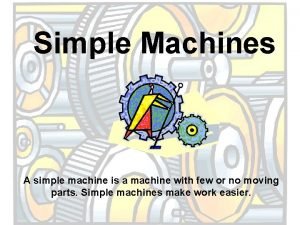Simple Machines Simple Machine a device that changes

































- Slides: 33

Simple Machines

Simple Machine - a device that changes the size or direction of a force being used to do work.

WORK: You are doing work when you use a force to cause motion in the same direction. To measure the amount of work , multiply the force times the distance the object moved.

Work = F x D (work= force x distance the object moved) W F*D

Force (or weight) is measured in newtons Distance is measured in meters.

The unit of measure for work = Joule (J)

We can measure how much the force is changed by calculating mechanical advantage.

The force applied to do work is called the effort force (input).

The force that opposes motion is called the resistance force (output).

Actual mechanical advantage is the number of times a machine multiplies an effort force.

Ideal mechanical advantage does not consider friction.

There are six types of simple machines • • • Lever Incline plane Wedge Screw Pulley Wheel and axle

LEVER: The lever is a simple machine made with a bar free to move about a fixed point called a fulcrum.

There are three types of levers. • First class • Second class • Third class

A first class lever is like a teeter-totter or seesaw.

First class lever. Effort Force Fulcrum Resistance Force

A second class lever is like a wheelbarrow. The long handles of a wheel barrow are really the long arms of a lever.

Second Class Lever Resistance Force Fulcrum Effort Force

A third class lever is like a fishing pole. When the pole is given a tug, one end stays still but the other end flips in the air catching the fish.

Third class lever Effort Fulcrum Resistance

The mechanical advantage of a lever is calculated by dividing the Resistance force by the Effort Force. MA = RF/EF

INCLINED PLANE: An inclined plane is a simple machine with no moving parts. It is simply a straight slanted surface. (Ex. a ramp. )

A box with mass of 30 Newtons is lifted 10 meters to the top of a loading dock. 10 30

With the incline plane the effort distance is increased, and the effort force is decreased. 18 20

The effort force can be further reduced by increasing the length of the effort distance. 10 30

The mechanical advantage of an inclined plane is calculated by dividing the Resistance force by the Effort force. MA = RF/EF

The ideal mechanical advantage of an inclined plane is calculated by dividing the Effort distance by the Resistance distance. IMA = ED/RD

PULLEY: A pulley is a simple machine made with a rope, belt or chain wrapped around a grooved wheel. A pulley works two ways. It can change the direction of a force or it can change the amount of force.

A fixed pulley changes the direction of the applied force. (Ex. Raising the flag). A movable pulley is attached to the object you are moving.

The mechanical advantage of a pulley is calculated by dividing the Resistance force by the Effort force. MA=RF/EF

Power is the amount of work done in a period of time. Power is calculated by the following formula: P=W/t

Efficiency is the ratio of the work calculated by (output work/input work) * 100.

Compound machine a machine that is a combination of two or more simple machines.
 A machine is a device that changes a
A machine is a device that changes a Cpu output device
Cpu output device Compound machine with 3 simple machines
Compound machine with 3 simple machines Phân độ lown
Phân độ lown Block av độ 2
Block av độ 2 Thể thơ truyền thống
Thể thơ truyền thống Thơ thất ngôn tứ tuyệt đường luật
Thơ thất ngôn tứ tuyệt đường luật Chiến lược kinh doanh quốc tế của walmart
Chiến lược kinh doanh quốc tế của walmart Tìm vết của đường thẳng
Tìm vết của đường thẳng Con hãy đưa tay khi thấy người vấp ngã
Con hãy đưa tay khi thấy người vấp ngã Tôn thất thuyết là ai
Tôn thất thuyết là ai Gây tê cơ vuông thắt lưng
Gây tê cơ vuông thắt lưng Sau thất bại ở hồ điển triệt
Sau thất bại ở hồ điển triệt Changes in latitudes, changes in attitudes meaning
Changes in latitudes, changes in attitudes meaning Chemical change examples pictures
Chemical change examples pictures Device made up of more than one simple machine
Device made up of more than one simple machine Differentiate between simple machine and compound machine
Differentiate between simple machine and compound machine A tagout device is preferable to using a lockout device.
A tagout device is preferable to using a lockout device. Input device dan output device
Input device dan output device Uses of wedge
Uses of wedge Is fax machine an output device
Is fax machine an output device Extended hardware concepts
Extended hardware concepts Fax machine is input or output device
Fax machine is input or output device Ma = fr/fe
Ma = fr/fe Output devices for physically challenged users
Output devices for physically challenged users Is fax machine an output device
Is fax machine an output device Find the efficiency of a machine that does 800 j
Find the efficiency of a machine that does 800 j What is an slogan
What is an slogan Examples of wedge
Examples of wedge Sample of inclined plane
Sample of inclined plane Slide is an example of simple machine
Slide is an example of simple machine Bike simple machine
Bike simple machine What type of simple machine is a lawn mower
What type of simple machine is a lawn mower Simple machines webquest
Simple machines webquest
